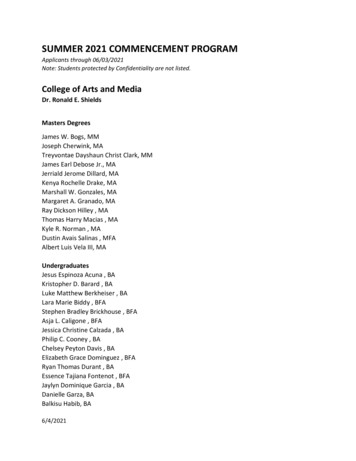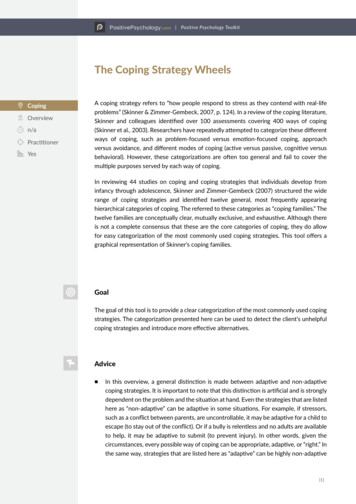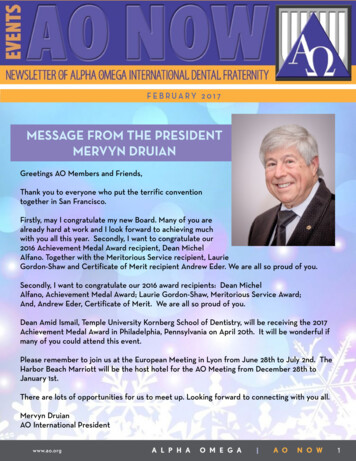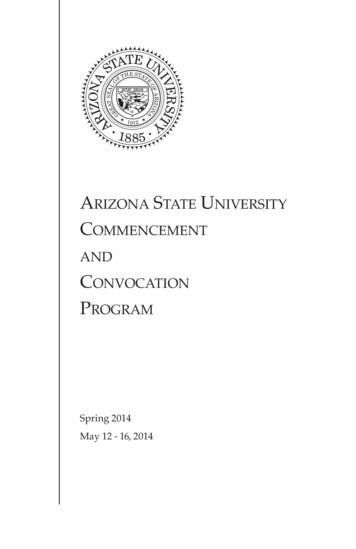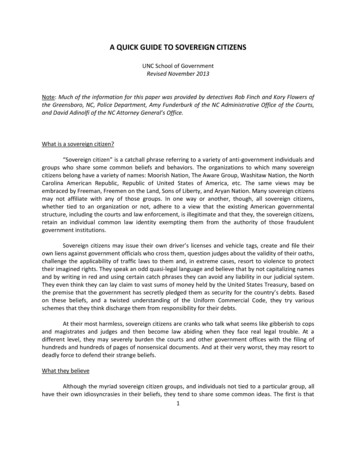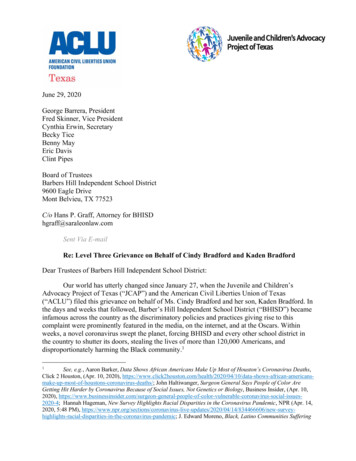
Transcription
June 29, 2020George Barrera, PresidentFred Skinner, Vice PresidentCynthia Erwin, SecretaryBecky TiceBenny MayEric DavisClint PipesBoard of TrusteesBarbers Hill Independent School District9600 Eagle DriveMont Belvieu, TX 77523C/o Hans P. Graff, Attorney for BHISDhgraff@saraleonlaw.comSent Via E-mailRe: Level Three Grievance on Behalf of Cindy Bradford and Kaden BradfordDear Trustees of Barbers Hill Independent School District:Our world has utterly changed since January 27, when the Juvenile and Children’sAdvocacy Project of Texas (“JCAP”) and the American Civil Liberties Union of Texas(“ACLU”) filed this grievance on behalf of Ms. Cindy Bradford and her son, Kaden Bradford. Inthe days and weeks that followed, Barber’s Hill Independent School District (“BHISD”) becameinfamous across the country as the discriminatory policies and practices giving rise to thiscomplaint were prominently featured in the media, on the internet, and at the Oscars. Withinweeks, a novel coronavirus swept the planet, forcing BHISD and every other school district inthe country to shutter its doors, stealing the lives of more than 120,000 Americans, anddisproportionately harming the Black community.11See, e.g., Aaron Barker, Data Shows African Americans Make Up Most of Houston’s Coronavirus Deaths,Click 2 Houston, (Apr. 10, 2020), -coronavirus-deaths/; John Haltiwanger, Surgeon General Says People of Color AreGetting Hit Harder by Coronavirus Because of Social Issues, Not Genetics or Biology, Business Insider, (Apr. 10,2020), 2020-4; Hannah Hageman, New Survey Highlights Racial Disparities in the Coronavirus Pandemic, NPR (Apr. 14,2020, 5:48 PM), al-disparities-in-the-coronavirus-pandemic; J. Edward Moreno, Black, Latino Communities Suffering
On May 25, our world changed yet again when George Floyd, a Houston native, wasbrutally murdered by police officers on the streets of Minneapolis. His death and the policekillings of Breonna Taylor, Tony McDade, Michael Ramos, and countless others have sparkedglobal protests and a renewed outcry against the virulent racism that plagues our society. InMount Belvieu and across the country, officials at all levels of government are responding tocenturies of racism by reexamining, questioning, and changing policies that systemically hurt,disadvantage, and oppress Black Americans.Through this grievance, you have a chance today to revise your district’s policies thatharm Black students and to allow students like Kaden to attend BHISD schools while wearingtheir natural Black hair. You can decide right now to empower Kaden to return to school and tochange the BHISD grooming code so that other Black students are not similarly discriminatedagainst in the future. By granting this grievance, you can immediately make BHISD a morewelcoming and accepting environment for students of every race and gender while committingyourselves to the difficult but necessary work of dismantling white supremacy.This is not only fair and just for Kaden and the entire Barber’s Hill community, but isalso what is required by the Constitution and federal laws, including very recent case law fromthe United States Supreme Court. Instead of being embroiled in litigation for months or years tocome and spending potentially hundreds of thousands of dollars in attorneys’ fees,2 BHISD hasan opportunity today to change its discriminatory policies and to take a critical step to resolvethis dispute.I.Factual BackgroundKaden Bradford has attended BHISD schools since pre-kindergarten and was enrolled asa sophomore at Barbers Hill High School when this grievance was filed. Kaden has beenattending BHISD schools for the past twelve years, and almost all of his friends attend BarbersHill High School. Because of the discriminatory treatment he experienced while at BHISD,Kaden was forced to withdraw from Barbers Hill High School after he filed this Level OneGrievance.3 Although he finished the semester at a nearby school district, Kaden urgently seeksto return to BHISD so that he can start his second half of high school with all of his friends.Disproportionately From Coronavirus, Statistics Show, The Hill (Apr. 7, 2020, 10:07 ately-fromcoronavirus.2A school district in Central Texas that engaged in a legal dispute with the ACLU of Texasrecently spent nearly 100,000 in attorney’s fees for a matter that did not go to court. These costs wereincurred at the detriment of the district’s students, parents, and taxpayers, and would have been far higherif the district had decided to engage in litigation rather than agreeing to change its unconstitutionalconduct during a Level 3 grievance hearing. See Christian Flores, Wimberley ISD spent nearly 100,000in fight over rainbow-altered logo, CBS Austin (June 8, edlogo#.3BHISD’s Level Two decision erroneously states that Kaden withdrew before his Level Onehearing. Kaden was forced to withdraw after the Level One hearing when his principal, Rick Kana, toldhim that Kaden would remain in ISS for the duration of the grievance process. Long-term suspension,2
For the past year and a half, Kaden has also been active in marching band, where he playstrombone. He is currently missing out on summer band opportunities that he would normallyparticipate in, and he seeks immediate enrollment in BHISD so that he can return to summerband at the end of July.Kaden has worn locs since sixth grade without any incident as a way of expressing hisBlack identity and culture. Locs are ropelike strands of hair that form naturally and/or are styledin afro-textured hair.4 Locs have been traced to just about every civilization in history, starting in2500 B.C.5 However, locs are directly related to the culture of members of the African diaspora.Black hair differs from all other races in its basic shape and composition.6 Black hair growsoutwardly, in thick and tight coils. It is groomed and shaped into locs or can be groomed intoother natural hairstyles and formations.7 In other words, locs are a product of natural hair growth.Grooming Black hair into locs can be critical to preserve hair health.8 This style is one of theprimary ways in which Black people are able to maintain natural, long, and healthy hair.Throughout middle school and his first year of high school, Kaden had no problemswearing his natural Black hair in school. BHISD’s grooming code for middle and high schoolstudents required that “[b]oy’s hair will not extend below the eyebrows, below the ear lobes, orwhether in school or out of school, has severe impacts on a student’s achievement; Ms. Bradford had nochoice but to withdraw Kaden after the Level One hearing because Rick Kana notified her that Kadenwould be held in ISS indefinitely. See, e.g., Cara H. Drinan, The War on Kids 49-52 (2018); Daniel J.Losen & Amir Whitaker, Lost Instruction: The Disparate Impact of the School Discipline Gap inCalifornia 3–5 (2017); Emily Boudreau, School Discipline Linked to Later Consequences, UsableKnowledge (Sep. 16, 2019), iscipline-linked-laterconsequences.4This letter uses the term “locs” instead of “dreadlocks” because of the negative and derogatoryimplications of the word “dread.” See Letter from ACLU of Florida and NAACP Legal Defense Fund, p.2 (Nov. 29, 2018) available at, y-v-books-christianacademy-complaint citing Shauntae White, Releasing the Pursuit of Bouncin’ and Behavin’ Hair: NaturalHair as an Afrocentric Feminist Aesthetic for Beauty by Brown White, International Journal of Media andCultural Politics (December 2005), available 27 Releasing the pursuit of bouncin' and behavin'hair natural hair as an Afrocentric feminist aesthetic for beauty).5The long history of locs can be traced back to The Vedas, where Egyptian pharaohs also worelocs. See Princess Gabbara, “The History of Dreadlocks,” EBONY (Oct. 18, 2016), available athttps://www.ebony.com/style/history-dreadlocks/ (citing Bert Ashe, Twisted: My Dreadlock Chronicles(June 2015)).6See Audrey Davis-Sivasothy, The Science of Black Hair: A Comprehensive Guide to TexturedHair (2011).7Discrimination against Black hairstyles is not an isolated event. There have been documentedincidents all over the country that ban locs from being sported in schools and places of employment. Seesupra note 1.8Locs and braided hairstyles are a means to protect the hair and create an easier way to style Blackhair. See Maiysha Kai, “Non-Compliant: The War Against Black Students’ Hairstyles Continues,” THEROOT (Aug. 21, 2018), available at r-against-blackstudents-hairstyle-18284892333
below the top of a t-shirt collar. Corn rows and/or dread locks are permitted if they meet theaforementioned lengths.”In compliance with this policy, Kaden wore his hair up and away from his eyebrows, earlobes, and the top of his collar during the school day. Kaden participated in marching band andwas pictured in yearbook photos for multiple school years while wearing locs that were kept upand away from his eyebrows, ear lobes, and collar. Along with his cousin, De’Andre Arnold,Kaden was one of only three students at Barbers Hill High School who wore locs, out ofapproximately 1,500 students at the school.During Kaden’s freshman year, Barbers Hill High School Principal Rick Kana mentionedthat Kaden’s hair was “getting a little long, length-wise.” However, the Principal explicitly toldhim that he could wear his hair up in a ponytail or otherwise keep it away from his eyebrows, earlobes, and the top of his collar.On December 16, 2019, the BHISD Board of Trustees voted to revise its dress andgrooming policy in the middle of the school year without any notice or warning to parents orstudents. The Board changed the hair policy to the following:Male students’ hair will not extend, at any time, below the eyebrows, or below theear lobes. Male students’ hair must not extend below the top of a t-shirt collar orbe gathered or worn in a style that would allow the hair to extend below the topof a t-shirt collar, below the eyebrows, or below the ear lobes when let down.After this policy change was enacted, Ms. Bradford received a phone call from Principal Kana.He said, “Ms. Bradford, we need to decide what the boys will do with their hair . . . If it was upto me, I would say I would cut it off and get a haircut.”When Kaden returned to school in January, Principal Kana and other schooladministrators repeatedly confronted him and Ms. Bradford about the need to cut Kaden’s hair.Even though he continued to wear his locs up and away from his eyebrows, ear lobes, and the topof his collar—as he had done for multiple years—school officials insisted that he was now out ofcompliance with District policies.In an effort to placate school administrators’ requests, Ms. Bradford asked Principal Kanaon January 6 if Kaden could put his hair in cornrows that were tightly braided against his head inorder to keep them off of his eyebrows, ear lobes, and the top of his collar.9 Principal Kana toldher that this would be okay and would comply with District policy. But after Kaden’s motherpaid 80 to get his hair braided so that he could return to school on January 14, the Principal saidthat he was still out of dress code and would have to get it cut after all. Mr. Kana told Ms.Bradford on January 14 that if Kaden did not cut his locs, he would have to go to ISS for a day ortwo and then would be sent to BHISD’s District Alternative Education Program (DAEP).9Cornrows, like locs and braids, are another protective style that members of the African diasporause to style their natural hair or allow their hair to “rest.” See Princess Gabbara, “Cornrows andSisterlocks and their Long History,” EBONY (Jan. 20, 2017), available know-about-cornrows/4
Ms. Bradford filed a Level One grievance on behalf of her son on January 27, and Kadenwas sent by school officials to ISS on January 29. Kaden then spent a week and a half in ISS,where he was treated as a troublemaker, even though he had never before been disciplined atschool. Forced to sit in silence for the majority of the school day, Kaden was cut off from hisfriends and no longer allowed to participate in school activities like band, which made him feeldepressed and isolated. Kaden also fell behind academically because he was denied the sameclassroom instruction as all of his peers.On February 6, Kaden and Ms. Bradford attended a Level One grievance hearing withPrincipal Kana. During that hearing, the Bradford family asked that Kaden be allowed to returnto regular classes so that he could receive classroom instruction while this grievance waspending. Ms. Bradford and her son also asked the District to reverse its discriminatory policychange that caused Kaden to be sent to ISS after several years of wearing his hair in locs withoutany problems at BHISD schools.During this hearing, the attorney for JCAP showed Principal Kana a binder withapproximately 200 photographs of non-Black male students in BHISD schools who wear longhair that violates the District dress code while participating in school activities. Several of thesestudents were featured with hair that violates the District dress code on multiple occasions andduring multiple years. Many of these students currently attend Barbers Hill High School, andphotographs of them wearing long hair that is clearly out of compliance with the grooming codecontinue to be prominently displayed on the District’s website as of the filing of this appeal.10Despite all of this evidence, Principal Kana told Ms. Bradford that Kaden would beforced to return to ISS only 20 minutes after the Level One hearing. “I’m sorry, but Kaden willhave to remain in ISS until further notice,” he said. Because Kaden had already been in ISS forseven instructional days at this point and was not receiving classroom instruction, Ms. Bradfordfelt like she had no other option but to enroll him in another school. She took Kaden home thatday and spent the next two weeks transferring him to another school. This was a stressful anddifficult process, and it took the new school district several days to decide whether to admit herson as a mid-semester transfer. The new school eventually approved this request and said thatKaden would be allowed to enroll without being forced to cut his hair and lose part of hiscultural identity. However, this new high school is much farther away from the Bradfordfamily’s home than Barbers Hill and has forced Ms. Bradford to completely change her workschedule to spend more time taking Kaden to school.Importantly, Kaden also knows no one at his new school while his entire friend groupfrom pre-K through sophomore year remains at Barbers Hill. Kaden therefore seeks to return toBHISD immediately, as long as he is permitted to receive regular classroom instruction andparticipate in extracurricular activities without being forced to cut his natural Black hair.Notably, the Bradford family has been impacted by the COVID-19 pandemic, whichexacerbates Kaden’s situation. Ms. Bradford works as a school bus driver, and her hours at work10See, e.g., “Athlete of the Week,” Barbers Hill High School (accessed Feb. 27, 2020), available athttps://www.bhisd.net/high-school-home.5
have been drastically cut, which has affected the family’s finances. In addition to the financialstrain, Kaden does not even know where he will start school in the fall because of BHISD’scontinued refusal to allow him to reenroll in BHISD and receive regular classroom instructionwithout being forced to cut his locs. He also seeks immediate reenrollment in the District so thathe can participate in summer marching band, which he has participated in for the past two years.As Kaden embarks on his second half of high school during a global pandemic, he wantsto return to school in the District where he has forged lifelong friendships for the past twelveyears. And even though he was previously permitted to wear his locs without incident, Kaden isnow being denied an education at Barber’s Hill High School because of BHISD’s discriminatorypolicies and practices.II.Legal ConcernsA. School District Administrators Are Enforcing the Grooming Code in RaciallyDiscriminatory WaysBy disciplining Kaden Bradford for wearing his natural Black hair while similarlysituated white students are not disciplined, the school district is subjecting him to disparatetreatment on the basis of race.11 Such conduct violates the Equal Protection Clause and Title VI,which prohibits discrimination based on race, color, or national origin in educational programsreceiving federal funding.12 Title VI forbids school districts from treating Black studentsdifferently than similarly situated students who are not members of the protected class.13 Yetabundant documentary evidence indicates this is exactly what the District is doing. As providedat the Level One hearing, there are dozens of pictures culled from yearbooks of non-Black malestudents at BHISD who wear long hair while engaging in school activities like playing on thebasketball team. Numerous photos show non-Black male students wearing long hair overconsecutive years of yearbook photos and even participating in graduation. Kaden, on the otherhand, has not been given this latitude. This presents powerful evidence of prima facie racediscrimination.14 And in the Fifth Circuit, treating students differently based on “ethnic hair11As the New York City Commission on Human Rights recently articulated, “[a]nti-Black bias . . .includes discrimination based on characteristics and cultural practices associated with being Black,including prohibitions on natural hair or hairstyles most closely associated with Black people. Bans orrestrictions on natural hair or hairstyles associated with Black people are often rooted in white standardsof appearance and perpetuate racist stereotypes that Black hairstyles are unprofessional. Such policiesexacerbate anti-Black bias in employment, at school, while playing sports, and in other areas of dailyliving.” See Legal Enforcement Guidance on Race Discrimination on the Basis of Hair, NYC Commissionon Human Rights (February 2019), available at rGuidance.pdf.1242 U.S.C. § 2000d.13See Bell v. Ohio State Univ., 351 F.3d 240, 253 (6th Cir. 2003); see also Washington v. JacksonState Univ., 532 F. Supp. 2d 804, 810 (S.D. Miss. 2006).14See Ihegword v. Harris Cty. Hosp. Dist., 929 F. Supp. 2d 635, 645 (S.D. Tex. 2013). If a case likethis goes to court, it would be expensive and involve extensive discovery into every racial comment thatschool administrators have made to the media, to students, and to each other. Such discovery would emails, text messages, documents, and remarks during and after the school day to exemplify race-basedmotives for actions taken against these students, as well as other students of color in BHISD’s history.6
styles” has been recognized as a form of racial discrimination in violation of the Equal ProtectionClause and Title VI.15The District’s unannounced mid-year policy change—a change which targets only ahandful of Black students—suggests the policy change could have been racially motivated,which has long been illegal in this country.16 But even if the District did not intend to raciallydiscriminate against Kaden, the documentary evidence shows significant implicit bias by schooladministrators in the manner in which the grooming code is enforced. This is not only illegalunder federal nondiscrimination law but also compounds the epidemic across the country ofBlack male students being disciplined more harshly and disproportionately than non-Blackstudents, an epidemic engulfing Texas and Barbers Hill.17 BHISD now has a chance to remedysuch discrimination and ensure that students like Kaden are not denied educational opportunitiesthat have been afforded to their non-Black peers.B. The Dress and Grooming Code at BHISD Fails to Comport with Supreme CourtPrecedentAs currently written, BHISD’s dress and grooming code imposes disparate requirementsfor students on the basis of sex, which is clearly out of step with modern Supreme Courtjurisprudence and intrinsically leads to disparate impacts based on race.The Constitution prohibits government entities from drawing gender classifications basedon “overbroad generalizations about the different talents, capacities, or preferences of males andfemales.”18 When a government entity imposes a rule based on gender, that rule must be“substantially related to an important government objective” and must have a justification that is“exceedingly persuasive.”19 Such justifications may not be based on “archaic” and “overbroadstereotypes” about different genders.2015See Fennell v. Marion Indep. Sch. Dist., 804 F.3d 398, 415 (5th Cir. 2015).A court could examine such a policy change under the framework of Arlington Heights and find itto violate the Equal Protection Clause. See Vill. of Arlington Heights v. Metro. Hous. Dev. Corp., 429U.S. 252, 266 (1977).17Locked Out of the Classroom: How Implicit Bias Contributes to Disparities in SchoolDiscipline, NAACP Legal Defense Fund (2017); Diane Ewing, Suspensions & Expulsions in EarlyGrades: A Problem Texans Can Fix With Strategies to Support Teachers and Students, TEXANS CAREFOR CHILDREN (April 2017). Even when school districts do not perceive their actions as overtly racist,“implicit bias can subconsciously influence how a teacher or administrator responds” to differentsituations. According to the NAACP Legal Defense Fund, “[w]hile the biases themselves may never beeliminated, their effects in schools can be limited through a variety of interventions.” Among theseinterventions is “empathic discipline,” in which educators examine situations from the student’sperspective, thereby allowing them to “limit the effects of implicit bias” and unintentional racialdiscrimination. This is exactly what Ms. Bradford asks you to do here. By examining this situation fromKaden’s perspective, who wore his locs without incident for years, it becomes obvious that he is beingwrongfully denied an education by the District through no fault of his own.18United States v. Virginia, 518 U.S. 515, 533 (1996).19J.E.B. v. Alabama ex rel. T.B., 511 U.S. 127, 137 (1994); and Virginia, 518 U.S. at 533.20J.E.B., 511 U.S. at 131.167
Under this binding Supreme Court precedent, any government entity that treats peopledifferently based on sex must put forward an “exceedingly persuasive” the gender-baseddifference—not just for the underlying policy in general. So even though BHISD claims that itsgrooming code is designed to “teach grooming and hygiene, instill discipline, maintain a safe andpositive learning environment, prevent disruption, avoid safety hazards, and teach respect forauthority”—none of these reasons provides any basis for treating students differently based onsex. Kaden wearing his natural Black hair in locs does not affect any of these District goals, justas a female student who wears long hair does not cause any problems with hygiene, safety, ordiscipline. BHISD’s only possible justifications for its gender-based policy are the “archaic” and“overbroad stereotypes” about the preferences, habits, and appearances of male and femalestudents, which are not enough to withstand the standards established by the Supreme Court.The Seventh Circuit Court of Appeals recently declared unconstitutional a schoolgrooming code similar to BHISD’s sex-separated grooming policy. 21 Other courts have similarlyfound that imposing sex-specific grooming codes violates the Equal Protection Clause. 22BHISD explicitly justifies its grooming code on two cases from the Texas SupremeCourt.23 Decided more than two decades ago, these cases only concerned matters of state lawand did not address or consider binding Supreme Court precedent in subsequent cases whereexplicit sex classifications have been found unconstitutional.24 These cases were also based onthe premise that sex discrimination does not occur when there are “comparable burdens” placedon male and female students, but this legal doctrine has never been endorsed by the U.S.Supreme Court and was entirely undermined in a landmark decision on sex discrimination onJune 15, 2020.Two weeks ago, the U.S. Supreme Court emphasized that sex discrimination occurs whenany individual is treated worse because of sex, regardless of whether men or women as a groupare disfavored. In Bostock v. Clayton County, Georgia, the Supreme Court held that privateemployers “discriminate” against someone “because of sex” when an employer “intentionallytreats a person worse because of sex.” No. 17-1618, 2020 WL 3146686, at *5 (U.S. June 15,2020). This holding completely upends the rationale of the cases that the District relies on andcites in its FNCA (Legal), because sex discrimination is based on an individual and not“comparable burdens” between men and women. The parties in Bostock that argued for a21Hayden ex rel. A.H. v. Greensburg Community School Corporation, 743 F.3d 569, 571 (7th Cir.2014).22See, e.g., Sturgis v. Copiah County School District, No. 3:10-CV-455-DPJ-FKB, 2011 WL4351355, at *1 (S.D. Miss. Sept. 15, 2011) (requiring boys to wear tuxedos and girls to wear drapesviolated the Equal Protection Clause); Bonnie Peltier, et al. v. Charter Day School, Inc., et al., No. 7:16CV-30-H, Dkt. 216 at *31 (E.D.N.C. Mar. 28, 2019) (requiring girls to wear skirts was an impermissiblesex classification based on outdated stereotypes).23See FNCA (Legal), BHISD (July 1, 2002) (“Hair-length regulations that apply to boys but not togirls do not manifest such an affront to students’ constitutional rights to merit judicial intervention.Barber v. Colorado Indep. Sch. Dist., 901 S.W.2d 447 (Tex. 1995); Bastrop Indep. Sch. Dist. v. Toungate,958 S.W.2d 365 (Tex. 1997)).24See Sessions v. Morales-Santana, 137 S. Ct. 1678, 1692 (2017) (“For close to a half century, asearlier observed, see supra, at 1689 – 1690, this Court has viewed with suspicion laws that rely on‘overbroad generalizations about the different talents, capacities, or preferences of males and females.’”).8
narrower version of sex discrimination explicitly raised the issue of dress codes during briefingand oral argument, but the Supreme Court rejected their claims. Instead, the Court held that sexdiscrimination occurs when an individual is treated worse than others, regardless of anycomparable burdens on the group. Here, it is undisputed that Kaden would be permitted to wearhis natural hair of any length if he were female, and he is therefore being treated worse than hissimilarly situated peers because of sex.25If BHISD abandons its dress and grooming code policy that discriminates againststudents on the basis of sex, the District will not only comport itself with the Constitution’srequirements but will also alleviate the numerous discriminatory impacts that a sex-separateddress code creates across religion, sex, race, and the gender spectrum.26 For BHISD to forcethese students to fit a certain stereotype hurts their academic success and severely underminesthe diversity inherent in the school district and the world at large.C. BHISD May Also Be Violating These Students’ First Amendment RightsThe school district may also be unconstitutionally suppressing students’ freedom ofexpression. The Supreme Court has long held that students do not “shed their constitutionalrights to freedom of speech or expression at the schoolhouse gate.”27 The Fifth Circuit has alsorecognized that dress and grooming may “symbolize ethnic heritage, religious beliefs, andpolitical and social views.”28 This type of expression “is undoubtedly protected under the FirstAmendment if the message is likely to be understood by those intended to view it.”29 Just likeschool districts cannot prohibit students from wearing long hair to express their religiousbeliefs,30 so too can they not stop students from wearing natural Black hairstyles.Beyond the schoolhouse, the District also cannot suppress students’ right to express theircultural heritage. In finding that school uniforms are constitutional in the face of a FirstAmendment challenge, the Fifth Circuit emphasized that “[a]lthough students are restricted fromwearing clothing of their choice at school, students remain free to wear what they want afterschool hours.”31 But by changing its policies to prevent students from wearing long hair “whenpulled down,” BHISD now violates this rule and inhibits student expression outside theclassroom.25Although Bostock concerned Title VII, the federal non-discrimination statute for employment, the SupremeCourt and Fifth Circuit routinely use Title VII cases to interpret the meaning of “sex discrimination” in Title IX andthe Equal Protection Clause—both of which apply to BHISD and prohibit the District from discriminating againststudents because of sex, which is the same language that the Supreme Court interpreted in Bostock.26For example, many male students wear long hair as an essential element of who they are. Manystudents who are Jewish, Sikh, Rastafarian, or from various religious backgrounds may wear long hair aspart of their sincerely held religious beliefs. Black and Native American students sometimes wear longhair as part of their culture and ethnic heritage. And tr
other natural hairstyles and formations.7 In other words, locs are a product of natural hair growth. Grooming Black hair into locs can be critical to preserve hair health.8 This style is one of the primary ways in which Black people are able to m
